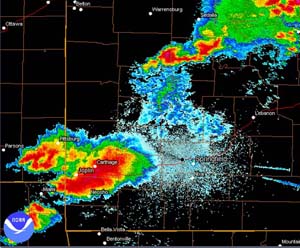 Keeping your business afloat after a disaster
Keeping your business afloat after a disaster
As the owner of a technology consulting firm, I’m occasionally asked to assist with Business Continuity Planning (BCP). As the name implies, BCP is a discipline that attempts to answer the “what if” questions that surround the viability of a business when faced with a disruptive event such as a fire, flood, hurricane, tornado, theft, riot, or any number of contingencies that could interfere with the normal course of business. BCP is meant to plan for such a disruption, giving the business a fighting chance to stay afloat and serve their customers until returning to business-as-usual at some point in the future.
The image for this post is from the NOAA radar from the May 22, 2011 tornado that struck Joplin Mo., the single deadliest tornado in U.S. history since modern record-keeping began in 1950. Rated EF-5 on the Enhanced Fujita scale, this mile-wide tornado was the largest and most powerful type, and it traveled 22 miles on the ground. The death toll attributed to this tornado was 161, with more than 1000 injuries.
He who fails to plan is planning to fail
–Winston Churchill
The Problem
The unfortunate thing about business continuity planning is the fact that I usually need to initiate the conversation. It’s human nature I suppose. Unless you’ve experienced a disaster, you tend to go through life assuming it’ll never happen to you. Even in “tornado alley”, where late May is the peak of the storm season, many of the deaths were ultimately preventable had the warnings been taken more seriously.
Joplin was an extreme example of what could happen. St. John’s Regional Medical Center, one of the region’s largest hospitals and a Level II trauma center, along with the surrounding medical facilities were hard hit, making the emergency response that much more difficult. The resulting patient surge coupled with the physical devastation of the facility and injuries to the staff has made the Joplin tornado a case study for disaster planners around the world.
To bring it home, what have you done to plan for a business disruption? An EF5 tornado is fortunately a rare occurrence, but any number of lesser disasters can, without proper planning, make it impossible to conduct business.
Data Loss Event
Most businesses rely on computers and servers to store the data that often makes up their business. Medical facilities, accounting firms, law offices, and nearly all other businesses are increasingly dependent on the data that drives their core business activities. How many, though, have complete confidence in their data backup systems?
- Are the backups occurring?
- Are you comfortable with the recovery point objectives and recovery time objectives?
- Do you even understand those terms?
- What if everything was suddenly gone… do you have offsite replication?
- Have you tested your solution?
Loss of Physical Access
What if your business becomes inaccessible due to a natural or man-made disaster? Any number of events could render your place of business inaccessible for days, weeks, or perhaps forever. Do you have a plan in place to conduct your business from a secondary location? Planning for this type of disruption should include the following:
- Physical office space
- Telecommunications portability
- Access to critical business data – electronic or otherwise
- Notification plans for vendors, clients, and staff
Summary
While this list is by no means exhaustive, it should serve to warn business owners of the need for business continuity planning. A disaster need not result in the end of a business – far from it. The better prepared business is in a position to thrive in hard-hit area simply by virtue of their ability to continue to serve their clients. Your competitors may not be so lucky.
Steven Thom is President of Thom Infotech, a West Chicago area computer consulting company. Steven is a member of the National Preparedness Coalition and is an amateur radio enthusiast and trained storm spotter. He has personal experience in disaster planning, helping a previous employer to recover from a fire that gutted their division headquarters.
